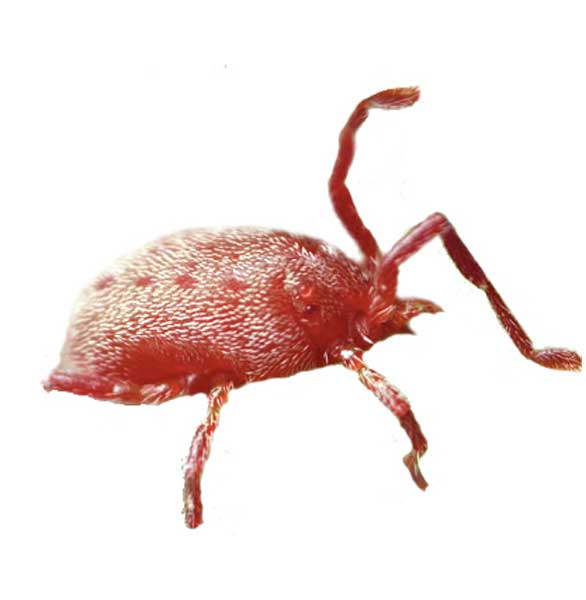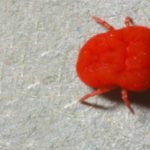Welcome To Our Chigger Learning Center
ChiggersChiggers are similar to ticks in that they are found in outdoor environments, such as grassy areas, forests, and fields. Chiggers are tiny but can be annoying. They latch onto a host (such as humans and certain animals) by piercing the skin and injecting digestive enzymes. This can cause red, itchy welts on the skin.
(Anthropoda Trombiculidae)
Description
Chiggers are tiny arachnids that are very small and challenging to spot with the naked eye. The diameter of larvae is less than 1/150 inch, while adults are about 1/60 inch. While chiggers themselves are hard to see without a microscope, you will likely see their bites. Chigger bites can be seen as small, red welts on the skin, and cause intense itching and irritation.
Chiggers are usually reddish-orange or yellowish in color. Larval chiggers are red with six legs, while adult chiggers have eight legs and are similar in appearance to other types of mites. They are often mistaken for red mites, but they are typically smaller with a more elongated body shape.

Additional Information
Habits & Behavior
 Chiggers like to hide out in grassy and wooded areas, especially in forests. They prefer damp areas, so it’s not uncommon to find them near lakes and streams. This is why many people are bitten by chiggers while hiking or camping.
Chiggers like to hide out in grassy and wooded areas, especially in forests. They prefer damp areas, so it’s not uncommon to find them near lakes and streams. This is why many people are bitten by chiggers while hiking or camping.
Adult chiggers spend winter underground and will deposit eggs once spring brings about warmer temperatures. The adults don’t usually stick around long enough to see the eggs hatch into chiggers. They die, leaving the baby chiggers on their own to find hosts, such as people and animals.
Chiggers infest people and animals during the summer months. In the United States, chiggers are mostly found in the south, southeast, and midwest. They are most active from early spring to early autumn. Chigger larvae are the ones that bite. They do not burrow into the skin; instead, they attach onto the surface of the skin.
After coming into contact with flesh, chiggers will begin to feed. Most chiggers will attack around the ankles or under the knees, but some will bite in the crotch and armpit areas. The chigger deposits digestive enzymes into the skin, which causes a rash and intense itching.
Food
Chiggers eat different foods at different life stages. Chiggers in the larval stage are the ones that are parasitic, feeding on hosts such as mammals (including humans), reptiles and birds. Contrary to popular belief, chiggers do not suck blood. Instead, they attach to the skin’s surface, injecting saliva containing a digestive enzyme into the skin. Chiggers feed by sucking up the liquefied tissues. They specifically feed on partially digested skin cells and lymph broken down by their saliva. Your body’s response is an itchy allergic reaction.
Adult chiggers, on the other hand, are not parasitic. They live in soil and do not eat host cells. Instead, they feed on various plant materials and other small arthropods. They can be beneficial to human beings, since they will eat other insects, such as mosquitoes, and their eggs.
Reproduction
Male and female chiggers do not directly mate with each other in order to reproduce. Instead, males deposit a spermatophore, or sperm packet. Females insert it into their genital pores to fertilize the eggs, which are then deposited in soil. Larvae emerge from the eggs and develop into a six-legged chigger.
Chiggers go through a complete life cycle that is split into four distinct stages: egg, larva, nymph, and adult. In the spring, adult female mites lay 1-5 eggs per day in vegetation and lawns. After 5-7 days, the eggs hatch into chigger larvae.
The entire life cycle can take anywhere from two months to one year. It is possible to produce as many as five generations of chiggers per year, depending on the temperature, moisture, and location.
Signs
Chiggers are so tiny that you won’t know they’re around unless they bite you. They do not get into your yard or home and make messes. They are pretty discreet.
So if you do get bitten by a bug of some sort during the night, how do you know it is from a chigger vs. a bed bug? There are some differences.
Chiggers are found in clusters and feed on your body for several hours or days. They will often feed until you wash them off. You may feel them on your skin but cannot see them.
Bed bugs tend to live near where you sleep.Your bed sheets or mattresses may have little spots of blood, black dots, rusty-looking stains, and even live bugs.
Also, chigger bites leave itchy, red bumps that can look like pimples, blisters, or small hives. Bed bugs also leave itchy, red bumps, but they tend to be more similar to mosquito bites or flea bites.
Dangers
Chiggers are not exactly dangerous. They do not get into homes and contaminate foods or other surfaces. In the United States, they do not spread any diseases, unlike mosquitoes or rodents. However, chiggers found in other parts of the world can spread bacteria called Orientia tsutsugamushi, which can cause a life-threatening disease called scrub typhus.
The biggest issue with chiggers is that they are annoying. If they bite you, prepare for pain and intense itching. Tiny red bumps can cause itching that can last for several days and even keep you awake at night. Your skin could also get blisters or a hive-like rash that may take 1-2 weeks to heal.
If you scratch too much, you could develop an infection. Therefore, it’s best to treat your bites in some way. Consider an over-the-counter anti-itch cream such as calamine lotion or hydrocortisone. You can also get relief from antihistamine pills such as Benadryl.
Contact Us Today
Chiggers are not as well-known as mosquitoes, flies, bees, and other insects, but they can be just as annoying.
If you have a chigger infestation in your yard, call Stride Pest Control right away and we’ll get your pest problems under control. Our experts focus on not only eradicating your home and yard of bugs, but also quality and customer relationships. To schedule a free consultation, fill out the online form or call (512) 777-1339 (Austin) or (210) 547-8410 (San Antonio).
Weeks for chigger “bites” to heal
1-2
Stages in a chigger’s life cycle
4
The average number of eggs in a clutch
3-8
Pairs of legs for adult chiggers
4
GET A FREE CONSULTATION TODAY!
Get a FREE Consultation

